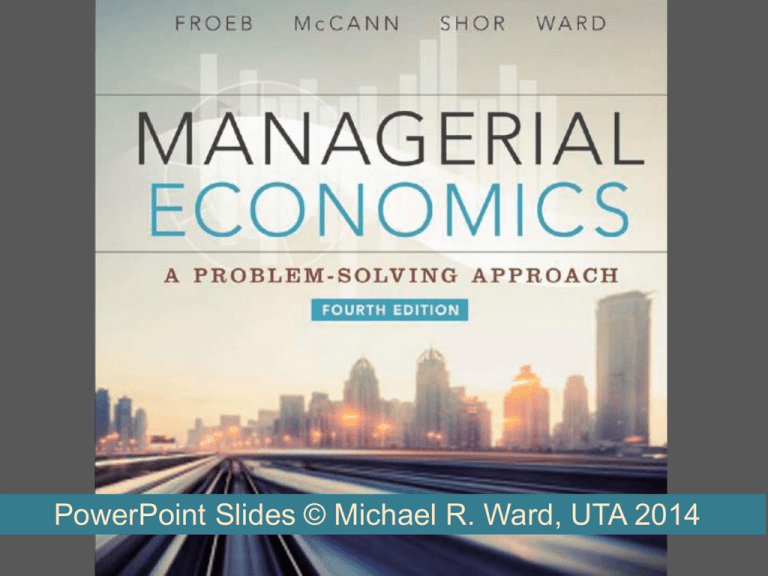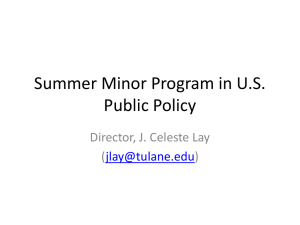ch23.slides.4e.MEAPSA.ward
advertisement

PowerPoint Slides © Michael R. Ward, UTA 2014 Econ 5313 The “Boundaries” of the Firm • Why are some tasks organized within firms and others across firms? • Hayek – Transacting across firms reveals price information that is useful for decision making • Coase – When costs of transacting between tasks too high and benefits too small, then include both tasks within the firm • Costs include the costs of “making a market” discussed earlier • Benefits include competition, price information: but these may have little value across some tasks • Firm boundaries where these two forces are equal Econ 5313 UC Power and Light • UC P&L sells electricity to customers at rates regulated by the state Public Utility Commission • UC P&L is allowed to earn a nine percent return on invested capital • The UC decided to buy its coal mine supplier • They formed a multi-divisional company, a regulated Power division, and an unregulated Coal mine • By raising the transfer price of coal sold to the Power Division, they Coal division evade the regulation that limits profit for the Power division • An increase in the price of coal raises the marginal cost of producing electricity (and Coal profit) Econ 5313 UC Power and Light • Under the profit regulation, this allows the Power Division to raise electricity prices • As a result, Coal earns more on the coal it sells; and Power is allowed to raise the regulated price of electricity so that its profit does not fall • In other words, the Coal Mine is more valuable as a sister division to the Power Company than it is as an independent company • This is an example of vertical relationships that can increase profit by giving firms a way to “evade regulation” Econ 5313 Managing Vertical Relationships Vertical relationships can increase profit through: 1. Giving firms a way to evade regulation 2. Eliminating the double-markup problem 3. Better aligning the incentives of manufacturers and retailers 4. Facilitating price discrimination 5. Solving holdup problems (discussed earlier) Econ 5313 Caveat: Beware of Acquisitions • Do not buy a customer or supplier simply because they are profitable • Your profit will not necessarily increase because the acquired firm’s profits are capitalized into the purchase price • Without some kind of synergy, the value of the upstream supplier or competitor is exactly equal to the size of its profit stream – not moving assets to higher value uses • In 1999 AT&T bought TCI’s cable TV assets for $97 Billion; then in 2002, they sold the cable assets to Comcast for $60 Billion • They destroyed $37 Billion in value Econ 5313 Evading Regulation • If unrealized profit exists at one stage of the vertical supply chain — as often happens when regulations limit profit — a firm can capture some of the unrealized profit by integrating vertically, by tying, by bundling, or by excluding competitors • How can you evade rent control? • Tying – must buy furniture from me • Bundling – comes with bundled furniture • Exclusion – prohibiting rival furniture companies Econ 5313 Evading Regulation • How can Multi-National companies evade national taxes using transfer pricing? • A company manufacturing in Mexico, for example, can transfer them at a low price to a sister division located in the Cayman Islands, and then to the United States at a high price, where they are sold to final consumers • The tax burden is reduced by realizing most of the profit in the Cayman Islands, which has lower taxes than Mexico • Regulators in Mexico anticipate this strategy, and force goods to be sold for at least a five-percent mark-up over cost before they are transferred out of the country Econ 5313 The Double Markup Problem • The double-markup problem occurs when firms selling complementary products set price in competition with each other • Vertical integration is one way of addressing the double marginalization problem – commonly owned firms can coordinate more easily on lower prices to raise profit • Recall the efficient transfer price across divisions does not include a margin so that the final good price can be “marginalized” just once • Same is true in the supply chain across firms Econ 5313 The Double Markup Problem • Upstream and downstream firms are supplying complementary services • Both processes needed to complete the final good • Double marginalization can occur for any two complementary goods – not just in the supply chain Econ 5313 • • • • • The Double Markup Problem Gasoline refiners both refine and retail gasoline Both “processes” are complementary There is a refining margin and a retailing margin Refiners purchase gas stations for this reason Vertical integration is one way of addressing the double marginalization problem – commonly owned firms can coordinate more easily on lower prices to raise profit Econ 5313 The Double Markup Problem • Gasoline refiners sell branded gasoline and convenience store items • Consumers demand the gas, as well as the retail items • When firms selling complementary products compete with each other, they price too high – not capturing profits of the other • Gas prices at stations with markets tend to be lower Econ 5313 Aligning Incentives • Getting retailers to invest in demand-enhancing services • With a smaller profit slice, retailers may under-invest in services that help enhance a brand name • Especially new products about which the customer is unaware • Need a way to compensate retailers for investing in pointof-sale services • This guarantees retailers a higher profit level creates incentive to provide demand-increasing services Econ 5313 Aligning Incentives • Limiting intra-brand competition also helps reduce freeriding, e.g., PING golf clubs require custom fitting • Tried to control level of intra-brand competition so as to give retailers incentive to do custom fitting • Prohibit sale over the Internet • Many of these tactics may be illegal under antitrust laws • Especially for companies with dominant market shares Econ 5313 • • • • • Aligning Incentives Kreepy-Krauly introduced first automatic pool cleaners Pool owners need to be convinced to spend thousands Set up displays in pool stores takes floor space Must compensate with higher margins Set minimum retail price – Resale Price Maintenance (RPM) • No worry that a discounter without the display will undercut you • Unfortunately, illegal Econ 5313 • • • • • • Aligning Incentives Alternative strategies: Pay for in-store service separately (shirking?) Supply service in-store by manufacturer Manufacturer supplies service outside of the store setting Resale Price Maintenance (RPM) Exclusive Territories Econ 5313 • • • • Aligning Incentives Other examples: Ex Coors requiring refrigeration Ex Does Coke buying retailers refrigerators exclude rivals? Ex Medication and blood tests Econ 5313 Aligning Incentives • Why are new products introduced to retailers with exclusive territories and then only later distributed through many competing retailers? • Exclusive territory confers market power on retailers • The higher margin compensates them for the extra sales effort needed for new products • After the product is proven, extra sales effort is no longer necessary and so more retailers are signed up • Ex iPhone and AT&T? Econ 5313 Price Discrimination • Manufacturer sells to two retail channels for two purposes • The low price channel wants to resell the input to the high price arbitrage the difference • Solve this by vertically integrating into low-price channel Econ 5313 Price Discrimination • Ex Herbicide users • Home gardeners are willing to pay $5 per liter for herbicide. • Farmers are willing to pay $3 per liter. • Vertical integration solves the pricing dilemma by preventing farm retailers from selling to home gardeners • Ex Aluminum • For airframes – few alternatives • For Pots and pans – many alternatives • Start line of pots and pans Econ 5313 Outsourcing • While technically the opposite of vertical integration, decisions to outsource should employ the same logic as decisions to vertically integrate • Outsource an activity to an upstream supplier or downstream customer if they can do it more profitably • Better focus on core competencies • The typical reason to outsource is to gain advantages of economies of scale or scope • Remember to consider whether you are sacrificing any integration benefits before you decide to outsource Econ 5313 Outsourcing 1. Outsourcing takes away control of upstream manufacturing processes or downstream distributors and retailers – harder to evade regulation 2. It may also create a double-markup problem 3. You may find it difficult to motivate your downstream customers or upstream suppliers to invest in activities that benefit you 4. You may find it more difficult to price discriminate 5. You may create hold-up opportunities Econ 5313 • • • • • • • From the Blog Chapter 23 Buying wedding dresses Microsoft / Nokia Merger Wii U Content Do stock brokers work for clients? TV programming and distribution Unwritten (humane treatment) clauses in supplier contracts Econ 5313 • • • Main Points Regulations may prevent moving an asset from a low valued use to a high valued use. Vertical integration may provide a mechanism to evade regulations. If both upstream and downstream firms have market power, final prices tend to include an inefficient doublemarkup. These can be reduced through vertical integration or appropriate contracting. Typically, manufacturers want retailers to set high quality, higher sales effort, high levels of promotional activities, and low prices. Retailers want the opposite. This incentive conflict can be mitigated through vertical integration, resale price maintenance, exclusive territories. Econ 5313 • • • • Main Points Often price discrimination schemes fail because distributers to the low price segment arbitrage the difference with the high price segment. Vertically integrating into the low price segment can reduce this arbitrage. Vertical contracting and integration can reduce holdup problems (discussed earlier). Most countries have laws regarding vertical integration. They are applied more when decisions by firms with market power affect competitors. Do not vertically integrate merely because your customer or supplier is profitable. Instead, identify if doing so changes behaviors to significantly address a problem.














